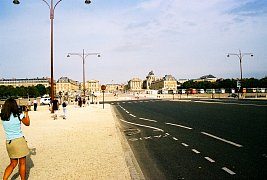 We got up early and took the train to the Palace of Versailles. Once again, it pays to get to
the popular tourist attractions just as they open, which in this case was 9 a.m. You can
take the train to Versailles from the same underground stations as he Metro. You need a
train ticket as opposed to a Metro ticket. If you have a Metro pass you can *get* to Versailles,
but the Metro ticket will not get you back. Better to buy your return ticket
while you are waiting for the train to go to Versailles.
We had a nice view of the backyards of common Parisians as we rode 15 miles or so
to our destination. You get off the train and then you have a six block or so walk to
the palace. Just follow the crowds (straight and then to the left). Today the Palace of
Versailles is one of France's national monuments. The building is so large that
only a small portion of it is open to the public. Many of the rooms are government
offices. Visitors may tour the sections of the north and south wings closest to the center
as well as the central section itself. Giant tour buses pulled up at 9 a.m..
We got up early and took the train to the Palace of Versailles. Once again, it pays to get to
the popular tourist attractions just as they open, which in this case was 9 a.m. You can
take the train to Versailles from the same underground stations as he Metro. You need a
train ticket as opposed to a Metro ticket. If you have a Metro pass you can *get* to Versailles,
but the Metro ticket will not get you back. Better to buy your return ticket
while you are waiting for the train to go to Versailles.
We had a nice view of the backyards of common Parisians as we rode 15 miles or so
to our destination. You get off the train and then you have a six block or so walk to
the palace. Just follow the crowds (straight and then to the left). Today the Palace of
Versailles is one of France's national monuments. The building is so large that
only a small portion of it is open to the public. Many of the rooms are government
offices. Visitors may tour the sections of the north and south wings closest to the center
as well as the central section itself. Giant tour buses pulled up at 9 a.m..
|
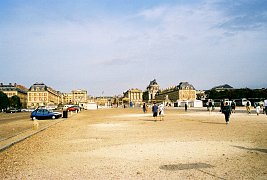 Versailles was the
royal residence of France for a little more than a
century- from 1682 until 1789, when the French Revolution began. Louis
XIII built a hunting lodge at the village outside Paris in 1624. This
small structure became the base on which was constructed one of the
most costly and extravagant buildings in the world. It was meant to
be a home for Louis XIV, the Sun King, who boasted of himself, "I am
the state." The men in charge of the project were Louis Le Vau, architect;
Charles Le Brun, painter and decorator; and Andre Le Notre, landscape
architect. About 37,000 acres of land were cleared to make room for
tree-lined terraces and walks and thousands of flowering plants.
There were 1,400 fountains and 400 pieces of new sculpture.
Versailles was the
royal residence of France for a little more than a
century- from 1682 until 1789, when the French Revolution began. Louis
XIII built a hunting lodge at the village outside Paris in 1624. This
small structure became the base on which was constructed one of the
most costly and extravagant buildings in the world. It was meant to
be a home for Louis XIV, the Sun King, who boasted of himself, "I am
the state." The men in charge of the project were Louis Le Vau, architect;
Charles Le Brun, painter and decorator; and Andre Le Notre, landscape
architect. About 37,000 acres of land were cleared to make room for
tree-lined terraces and walks and thousands of flowering plants.
There were 1,400 fountains and 400 pieces of new sculpture.
|
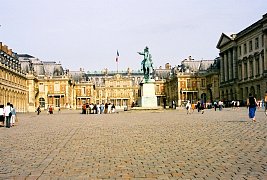 In 1676 another architect, Jules Hardouin-Mansart, was put in charge
of redesigning and enlarging the building. Starting with Le Vau's
plans, Hardouin-Mansart added a second story and built the magnificent
Hall of Mirrors and the north and south wings.
Construction of the palace went on through the next century.
More than 36,000 workers were involved in the project, and
when the building was completed it could accommodate up to
5,000 people, including servants. About 14,000 soldiers and
servants were quartered in annexes and in the town.
Louis XV left his successor, his grandson Louis XVI, a
huge debt that burdened the state when he died in 1774.
In 1676 another architect, Jules Hardouin-Mansart, was put in charge
of redesigning and enlarging the building. Starting with Le Vau's
plans, Hardouin-Mansart added a second story and built the magnificent
Hall of Mirrors and the north and south wings.
Construction of the palace went on through the next century.
More than 36,000 workers were involved in the project, and
when the building was completed it could accommodate up to
5,000 people, including servants. About 14,000 soldiers and
servants were quartered in annexes and in the town.
Louis XV left his successor, his grandson Louis XVI, a
huge debt that burdened the state when he died in 1774.
|
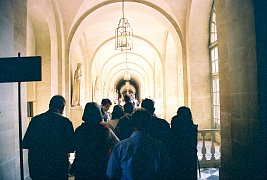
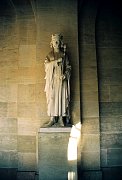
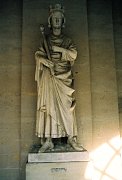 We went immediately to the center wing and waited perhaps 10 minutes in line. Then we
entered Versailles and walked along this corridor to the chapel. Along the wall are
various statues of notable Frenchpersons.
We went immediately to the center wing and waited perhaps 10 minutes in line. Then we
entered Versailles and walked along this corridor to the chapel. Along the wall are
various statues of notable Frenchpersons.
|
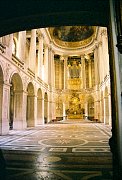 The construction of Versailles was completed near
the end of Louis XIV's life. This chapel was built last.
The construction of Versailles was completed near
the end of Louis XIV's life. This chapel was built last.
|
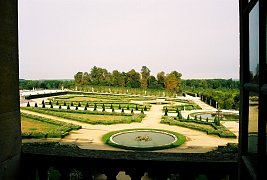 The beautiful gardens are visible through the windows. If you come late in the
day and don't want to wait in line, you can tour just the gardens.
The beautiful gardens are visible through the windows. If you come late in the
day and don't want to wait in line, you can tour just the gardens.
|
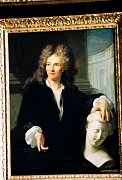
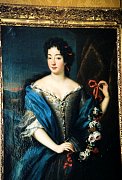
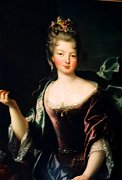 I took pictures of some of the portraits hung on the walls of the many
palace apartments we walked through. They are not of the greatest quality, but I wanted
to remember the dearth of art displayed at Versailles.
I took pictures of some of the portraits hung on the walls of the many
palace apartments we walked through. They are not of the greatest quality, but I wanted
to remember the dearth of art displayed at Versailles.
|
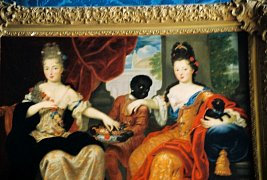
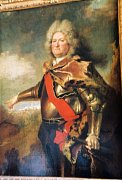 Just imagine the 'idleness" of the lives of these two women. I think the
gentleman at the right is Louis XVI.
Just imagine the 'idleness" of the lives of these two women. I think the
gentleman at the right is Louis XVI.
|
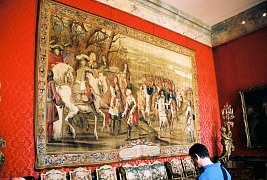
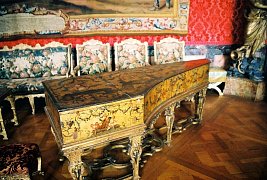
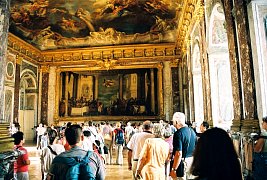
|
|
We almost had to miss this tour, since we had such a short stay in Paris.
Our schedule freed up and now I don't know how we could have missed this.
We are walking through the apartments on the ground floor once occupied by the
Dauphin and Dauphine.
|
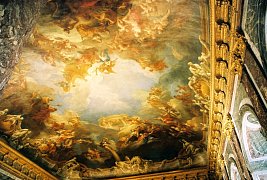
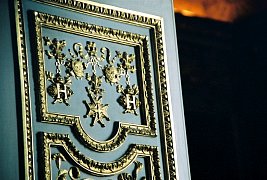
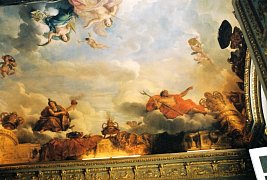
|
|
Above is two views of detail artwork on the ceiling and one of the doors. You can tell
real gold leaf by the look of how one sheet ends and another begins (there is a line).
This place has gold leaf, my friends.
|
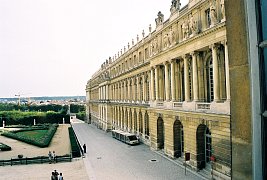
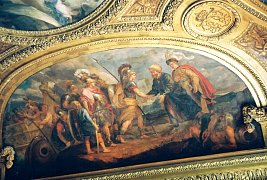
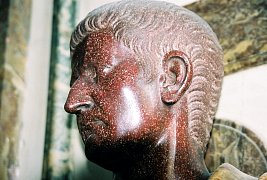
|
|
Another look out a window and some more ceiling detail (above) and this red granite (?) roman-like bust. Perhaps
the king used it to crack walnuts.
|
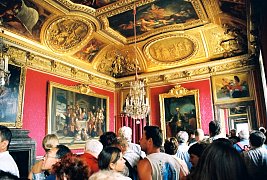
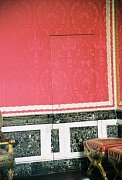
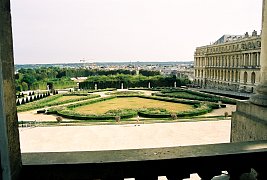
|
|
We are still following along with the crowd. There are quite a few people mixed in
with us now, but it is still easy to see things. I especially liked the hidden door
in the red room.
|
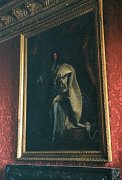 This gentleman is King Louis XIV who started this palace.
This gentleman is King Louis XIV who started this palace.
|
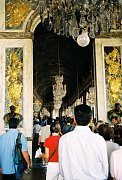 We have finally reached the Hall of Mirrors. All my life I have wanted to walk
here. Note the ornate entryway.
We have finally reached the Hall of Mirrors. All my life I have wanted to walk
here. Note the ornate entryway.
|
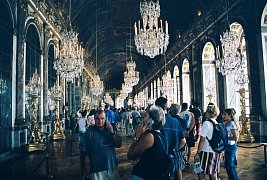
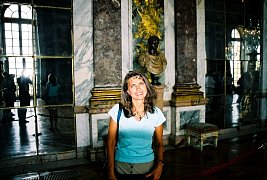
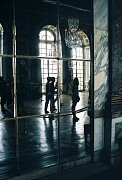
|
|
|
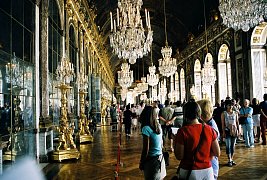
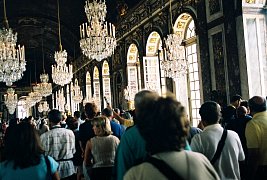
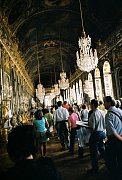
|
|
|
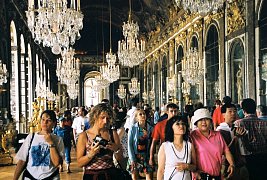
|
|
|
|
I was not impressed by the quality of my image in the mirrors. By today's standards,
the mirrors are extremely poor quality. But at the time they were manufactured most
mirrors were only big enough to fit in the palm of your hand and used up close.
It is very hard to imagine this candle lit hall hundreds of years ago being traversed
by the privileged few.
|
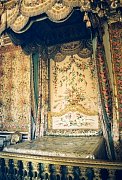 This bed doesn't seem too elegant right now, but considering most people back then probably
slept on straw, this is pretty opulent.
This bed doesn't seem too elegant right now, but considering most people back then probably
slept on straw, this is pretty opulent.
|
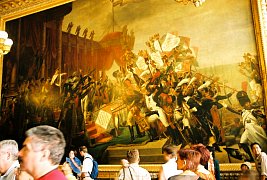 At the end of the tour we reached a room with many giant murals of French military
exploits from about 950 a. d. to the Napoleonic era. I supply these here just to give
the overall feeling of wandering around looking at them all.
At the end of the tour we reached a room with many giant murals of French military
exploits from about 950 a. d. to the Napoleonic era. I supply these here just to give
the overall feeling of wandering around looking at them all.
|
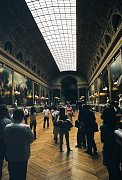
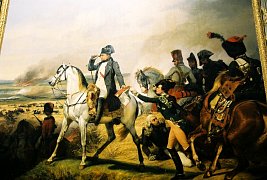
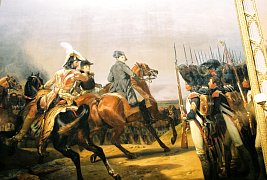
|
|
|
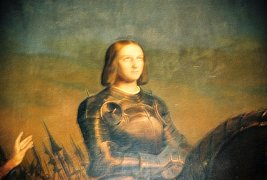 Joan of Arc. Sorry, not a very good picture.
Joan of Arc. Sorry, not a very good picture.
|
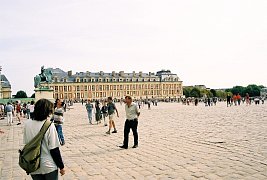 On the morning of October 6, 1789 a mob of angry Parisians, mostly women,
marched to the Palace demanding bread. They stormed the Palace, ran up the
Queen's Staircase and broke into the Guard's Room, then into the Antechamber.
Marie Antoinette ran from her bedchamber into her private apartments towards
the King's Suite to find her husband and son. Louis XVI, Marie Antoinette were
taken to Paris as prisoners with their children. They never saw the Palace of Versailles again.
On the morning of October 6, 1789 a mob of angry Parisians, mostly women,
marched to the Palace demanding bread. They stormed the Palace, ran up the
Queen's Staircase and broke into the Guard's Room, then into the Antechamber.
Marie Antoinette ran from her bedchamber into her private apartments towards
the King's Suite to find her husband and son. Louis XVI, Marie Antoinette were
taken to Paris as prisoners with their children. They never saw the Palace of Versailles again.
Note the *huge* line of people extending from the tour entrance where we went in. Can you
say 2 hour wait?
|








































